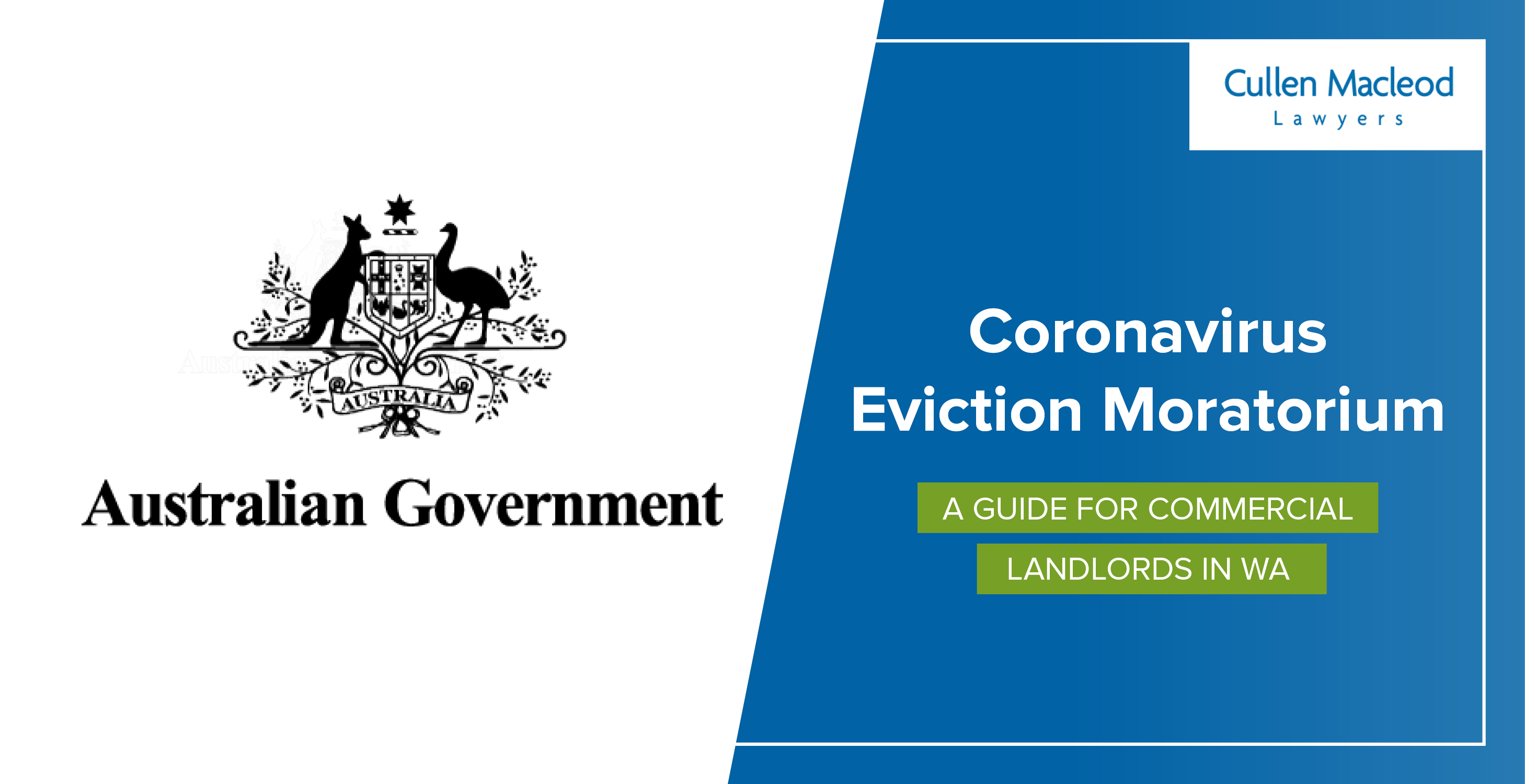What is the moratorium?
On 29 March 2020 the Prime Minister announced residential and commercial landlords would be banned from evicting tenants for the next six months due to the non payment of rent where the tenant is under financial stress caused by the coronavirus 19 economic downturn. This moratorium is part of the Government’s measures to assist businesses adversely impacted by the coronavirus, especially those that have been forced to cease trade as part of the State and Federal Government’s lock-downs to prevent the spread of the virus. A critical point is that the moratorium is a freeze on evictions, not a freeze on rent.
When is the moratorium effective from?

While the moratorium was announced by the Federal Government on 29 March 2020, implementation of the moratorium is the responsibility of the respective State and Territory Governments. This means there is currently no legal basis for the moratorium in WA until it is enacted into law. On 3 April 2020 the Prime Minister reported that the National Cabinet (which includes State Premiers and Territories’ Chief Ministers) is actively working on a code which is to be incorporated into relevant State and Territory legislation.
Who does the moratorium apply to?
Full details of who the moratorium applies to, and the relevant criteria is not yet known. It is clear from the guidelines presented by National Cabinet that the measure is designed to protect tenants who are currently, or who will, suffer from financial stress and unable to pay all or part of their rent due to impacts from coronavirus.
The guidelines set down by National Cabinet are as follows:
- The temporary moratorium on evictions will apply where rent isn’t paid by a commercial tenant hit by “severe rental distress” due to coronavirus.
- Rental payments be reduced or waived for a set time for affected tenants.
- Tenants be able to end leases or seek out mediation or conciliation on grounds of “financial distress”.
- Landlords and tenants not significantly affected by coronavirus are expected to honour their lease and rental agreements.
As with most things, the devil will be in the detail. For instance, what exactly will “severe rental distress” and “financial distress” mean, how is it measured and what is required to evidence it?
A critical point is that the measure is only intended for specific tenants in specific circumstances. A tenant who is not in severe rental distress or financial distress (whatever that means) is not entitled to the protections and is required to pay its rent and other monies in accordance with the lease.
What happens to rent in the meantime?
Unless there is an express provision in the lease, such as rent abatement or a force majeure clause, and the relevant criteria is satisfied, there is no legal obligation on the landlord to reduce or abate the rent and other monies payable under the lease by a tenant. Therefore a good starting point for a landlord is to review the lease to identify what, if any, rent relief provisions in the lease may apply in the circumstances or in the event of a rent abatement or rent relief request by a tenant.
The Federal and State Governments have strongly encouraged any tenant whose ability to pay rent has been adversely impacted by coronavirus to “start talking” with the landlord. That is, for the parties to work together to work out a position that works for them both to help ensure that both can survive and “be there on the other side”.
Some examples of the relief landlords have been willing to grant to tenants that we have seen recently include the following:
- Abatement of rent to a percentage, sometimes calculated with reference to turnover from the same period last year.
- Providing a rent free period in exchange for a longer term (or extending the term early), essentially equivalent to pre-allowing a rent incentive on renewal.
- Providing rent deferment. That is, rather than calling it a rent free period or rent abatement, insisting that the full rent is payable, but some or all is not payable until later on (after the crisis is finished).
- Providing a rent free period.
It is important to note that a landlord may be entitled to charge interest on any non-payment of rent. A decision will also need to be made as to whether any rent relief extends to the tenant’s obligations in relation to outgoings.
As to what, if any, rent relief is provided to a tenant will depend on the landlord’s own financial position and is a commercial decision. As noted above, unless there is an express abatement clause or other clause in the lease that can be relied upon, the decision by a landlord to reduce the rent or waive for a specified period is at its sole and absolute discretion. Any agreed changes to the current lease terms should be documented in writing, ideally in a formal Deed of Variation of Lease.
What if the tenant stops paying rent?
If a tenant has stopped paying its rent, the landlord is entitled to take action in accordance with the terms of the lease and if applicable, the terms of the Commercial Tenancy (Retail Shops) Act.
While eviction of the tenant will not be possible in the next six months due to the eviction moratorium, there may be other mechanisms the landlord can call upon to cover rental arrears, such as the bank guarantee or enforcing a guarantor’s guarantee.
We will update this information sheet as more details become known. In the meantime, for more information on the above, please contact Anton Conti or Susan Nicholson by telephone on 9389 3999 or by email at AConti@cullenmacleod.com.au or SNicholson@cullenmacleod.com.au



